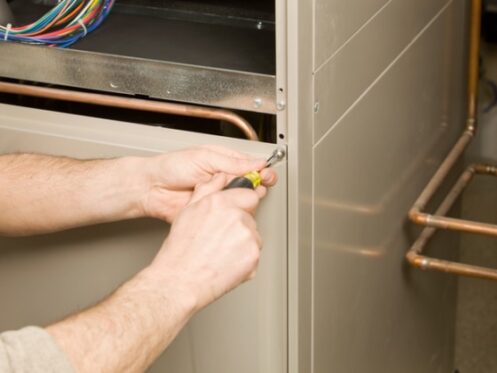If it plugs in, burns fuel, or consumes batteries, efficiency matters. And when you’re talking about a major appliance or machine – think furnaces, water heaters, or refrigerators – efficiency can have a serious impact on your wallet.
Take care. People like buying cars based on fuel economy. The more miles per gallon, the more efficient the vehicle. All else being equal, of course.
But what about when all things aren’t equal?
For example, a little hatchback isn’t going to get 40 MPG if you spend two hours per day in stop-and-go traffic. A small pickup traveling at highway speeds might do better. That’s because you’re subjecting the car to a hodgepodge of impediments that prevent it from achieving full efficiency. Rapid acceleration. Several stops. Dozens (hundreds?) of gear shifts. That little car is working hard!
It’s the same with furnaces.
An 80% furnace is only 80% efficient under ideal conditions.
All sorts of issues can prevent a furnace rated at 80% AFUE – that’s “standard” efficiency – from actually operating at that level of efficiency. This time of year, we see furnaces every day that are failing to deliver the sticker efficiency rating. What’s to blame? Everything from a lack of maintenance to poor HVAC design.
First of all, let’s be clear about what the “80%” rating means. A furnace’s AFUE, or annual fuel use efficiency, refers to the percentage of energy consumed by the unit that is used to heat your home. In an 80% AFUE furnace, 80% of the energy consumed by the furnace ends up heating the home. The remaining 20% is combustion exhaust.
The more strain you put on an 80% furnace, the less likely it is to operate at full efficiency. And then, sooner than you expected, your furnace will be 0% efficient.
Avoiding these 4 mishaps helps you optimize furnace efficiency.
When we see a furnace that’s failing to achieve its AFUE rating, it’s typically for one of these four reasons:
- Dirty burners: When your burners aren’t clean, they can impede the combustion process. They won’t burn as hot as they should, making it harder for the furnace to satisfy your thermostat setting. Burner flames should be blue. If they’re yellow, the burners are probably dirty.
- Gas pressure: Is yours set right? Every furnace has specific gas pressure requirements. If there’s too much gas, the furnace could get too hot. It’s like putting the pedal to the metal in your car and watching the tachometer max out.
- Dirty air filter: Indoor air quality isn’t the only reason to change your air filter regularly! A dirty filter can reduce airflow to the furnace, stressing your equipment to the limit. It can also shorten the lifespan of your heat exchanger.
- Undersized return: The effect is the same as with a dirty filter. Undersized returns reduce airflow to the system, forcing the furnace to work harder than it should to heat your home. Eventually, this will cause the furnace to fail prematurely. Think of it like a paperclip that you keep bending back and forth – it will keep bending for a while. But it eventually snaps.
Dirty burners and air filters are the results of inadequate maintenance. To address those problems, have your HVAC system inspected twice per year – once prior to the heating season and once prior to the cooling season. And change your air filter per the manufacturer’s instructions.
Improper gas pressure and undersized returns have to do with (faulty) system installation and (improper) design. You’ll need to hire an HVAC pro to adjust the gas pressure to the right level. But if you’ve got an undersized return, you’ll need a home performance professional to perform a Manual D calculation to determine the proper duct sizes for achieving optimal airflow. Then you’ll need to have new ducts installed.
One more thing: Be sure your HVAC tech uses a combustion analyzer.
While dirty burners and air filters are easy to address, other efficiency-reducing problems are trickier to diagnose. That’s why your HVAC company needs to test your equipment using a combustion analyzer whenever they perform a tune-up.
The combustion analyzer tells us whether your equipment is operating at the proper efficiency. If it’s not, we can troubleshoot. However, without the tool, there’s no way to know. And yes, a combustion analyzer is also the only tool that can tell you whether you do (or don’t) have a cracked heat exchanger.
The way we see it, thorough combustion analysis is not optional. It’s essential.
Combustion analysis gives you a definitive answer to the question, “Is my 80% furnace 80% efficient?” It’s also a first step toward saving on utility bills, getting more years out of your HVAC equipment, and keeping the indoor air quality in check.
If you’ve got a problem, you’ll know about it. And you can eliminate the impediments to peak furnace efficiency.

